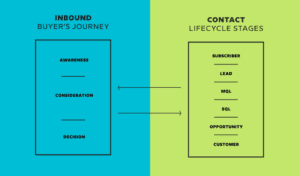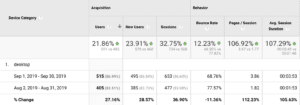
You’ve done the hard work—now it’s time to see if it paid off. There are many traditional ways you can measure the success of your website redesign, including surveying the increase (or potential decrease) of sales and the number of visitors in a given time frame.
But looking past dollars and sales conversions when it comes to website ROI can give you a broader look at the overall success of your website design. Some sites may even have different goals, like nonprofits seeking increased brand advocacy and awareness, that can be harder to track.
Whether you’re an e-commerce business website or a non-revenue-generating site, here are 5 ways you can—and should—measure the impact of your website redesign.
5 ways to measure the success of your website redesign
Before your website goes live: Read this list 5 things to do before you launch your new site! And make sure you’ve taken the time to set goals for your website. For most companies and websites, the goal will be to increase revenue. But there are other goals to consider, including increased engagement, greater brand legitimacy, or better user experience. Lay out realistic goals and give yourself a starting point based on honesty, not miracles.
Monitor your search rankings
We put this metric first because some companies think this is the holy grail of marketing success. While monitoring your rankings regularly is a great way to understand your site from above, it’s certainly not the only contributing factor to ROI.
Approximately 75% of searchers find their answer on Google’s first page.
So as you can see, unless you’re on page 1 of search results, you won’t get much traffic from organic search, meaning your search ranking isn’t as important as you think it is.
But, it can let you know what you’re doing wrong, or what you’re doing right. That’s why we still think it’s important to measure regularly.
If you start receiving more traffic from new or different keywords, you can start optimizing SEO to help track better for that result. Or if you notice that you’ve dropped significantly in pages, you may have a penalty on your site worth investigating.
Search rankings are a constantly moving and shifting algorithm that can be hard to wrangle—especially right after a website redesign. While being high on the Google list is obviously a great way to reach more people, it doesn’t necessarily dictate how optimized your website is—so we encourage looking deeper into your analytics to create a picture for success.
Understand your leads & their spot in the customer journey
There are many different stages in the lifecycle of a customer. What takes them from not knowing anything about your company to purchasing your product is considered their journey.

There are two main types of leads that marketers use for tracking purposes:
Marketing Qualified Lead (MQL)
This is a lead that has engaged with your marketing efforts but isn’t ready to close the deal. Typically this means they need more marketing or a free trial/sample before they will consider becoming a customer.
Sales Qualified Lead (SQL)
This is a lead who has expressed specific interest in purchasing your product, like filling out a form asking about a product. This is the hottest lead and should be easier to close upon.
Ideally, your website redesign efforts should bring in more MQLs and SQLs than pre-redesign. Knowing how many MQLs and SQLs you have and the path they take to become a sale can give you valuable insight into your customers’ journeys and how to push others down the same path.
Your website should integrate seamlessly alongside your CRM and marketing materials. That means contacting customers at the right place, using the right information. Collecting more information about user behavior and leads gives you the ability to further optimize key pages on your site.
If your site receives a lot of SQLs, but they don’t ever close, it may mean that you’re not providing an optimal experience or delivering the exact product or service that they’re looking for. And if your leads close at a higher rate—your ROI is pretty evident.
Without understanding your potential customers, it can be impossible to know if your website is bringing in quality leads.
Research the quality of website visits
Having more visitors is not the goal—having more qualified, engaged visitors is.
If your site is receiving a lot of visitors, but none of them are leads or conversions, you’re likely putting out the wrong marketing materials or your site is not optimized for your target audience.
A good way to understand the quality of each website visit is to research your bounce rates and how long visitors stay on your site.
If a person visits your site and then leaves immediately without engaging with anything, this negatively affects your bounce rate. This is different than an exit rate, which is when someone visits another page within your site before leaving. Having a high exit rate isn’t necessarily bad for pages like contact us, but if your product pages have a high exit rate, that equals lost money.
The bounce rate equation is the total number of visitors viewing one page divided by the total number of entries to that page. Exit rate is the percentage of a page’s views that are the last in the user’s session.
Here are a few ways to improve the bounce rate and exit rate on your website:
• Write higher-quality content that users want
• Optimize keywords to ensure you’re giving visitors the exact information they’re looking for
• Speed up page load times
• Market toward higher-quality leads, not mass numbers of people
The more engaged your leads are on your site, the more likely they will be to convert.
Track conversion rates
Having a website that helps you generate and close leads is like having an amazing sales rep on your side 24/7, communicating your information in a way that makes sense.
Conversion rate is the number of visitors who complete an action divided by the total number of website visitors in a given time frame. Simply, it’s how many people did what you wanted them to do.
Conversion rate is one of the best ROI tools available today—and it’s extremely easy to track for e-commerce sites. Ultimately, the goal should be to increase your conversions while spending the same amount on marketing.
If you’re a non-profit or a non-business site, tracking “conversions” can be a bit more difficult. Refer back to the goals you set out at the beginning of your redesign and see how you can track them. If one of your goals was more customer engagement, tracking newsletter sign-ups can be a great way to view conversions. Or if you want greater brand awareness, monitor how many people typed your site into their search bar.
Figure out what your conversion metrics should be, and then stay on top of them. If your conversions did not increase after a redesign, you could have bigger issues at hand, like poor user experiences or site navigation errors.
You may consider improving your website design to boost sales, even after your initial redesign.
Compare benchmark reports
Having ample data is the best way to make impactful website decisions. Make sure you have an exhaustive list of benchmarks that you can use to compare your before and after sites.
The metrics that you’ll want to benchmark depend a lot on your business and its unique needs, and we recommend starting with your key performance indicators (KPIs) and building from there.

Some examples of metrics we use in our benchmark reports include the things we listed above, in addition to:
• Number of sessions per user
• New vs. returning users
• Pages per session
• Average page time
• Organic traffic
Ultimately, your redesign should enhance all of these metrics over time. Having quantitative data from years past can help you understand if its a seasonal issue that you face regularly or a possible UX/UI issue that’s causing low (or high) conversions.
Without comparing against historical data, it’s hard to know exactly what the ROI is on your redesign. If you don’t have benchmark reports to pull from, you may consider holding off on your site until you can build up some information sets.
Conclusion
As they say: work smarter, not harder.
There are a lot of marketing tools (and free improvement methods) available today that can make this process much easier for your team.
Some of our favorite marketing tools include Google Analytics, Ahrefs, Google Search Console, and Tag Manager. We also love using heat mapping tools to help see what’s working and what’s not.
There are a whole host of ways to measure the success of your website redesign, and this is by no means an exhaustive list. Once you’ve gone through these measurements, do them again.
And again.
And again.
Redesigning a website is not a one-time task; it’s something that you will be optimizing continually over the next few years until you do a complete overhaul again. By defining your key objectives and comparing versions against them, there’s no end to improvement opportunities.
If you want to work with a team that’s experienced at designing user-friendly websites that get results, give us a shout. Your new website is just a call away.


